More and more, it seems like we are on the cusp of a break in the small arms “plateau”, and that major changes may be coming both in the technology and use of infantry small arms and ammunition. The biggest harbinger of this coming paradigm shift has been Picatinny’s Lightweight Small Arms Technologies (LSAT) program, now superseded by the Cased Telescoped Small Arms Systems (CTSAS) program. As CTSAS and similar programs make headway, it seems increasingly likely that some sort of next generation lightweight ammunition paradigm will force a shift in infantry small arms, and that the current fleet of metallic-cased ammunition and the weapons designed to fire it will have to be replaced by new designs.
This likely shift in technology may also bring with it a shift in how infantry weapons are configured and used, and indeed many in the industry believe it should bring about such a shift. This post will explore one of the most heavily promoted future infantry small arms system concepts: A shift from close range 5.56mm assault rifles and automatic rifles backed up by longer-ranged 7.62mm weapons in the weapons squad and used by designated marksmen in the rifle squads, to a new, longer ranged marksmanship-oriented force designed to achieve “overmatch” (i.e., to outrange) against enemy 7.62mm small arms, and to defeat them with superior precision and lethality of fire.
Post-publishing note: In the original release of this article, I didn’t adequately clarify two things. First, I am not a proponent of this theory of infantry weapons and tactics, but I have read a lot of work from and I have talked quite a bit with people who are. Second, this article doesn’t directly examine the question of whether a system like this should be adopted, but just assumes that such a system will be adopted and explores the advantages and disadvantages of doing so.
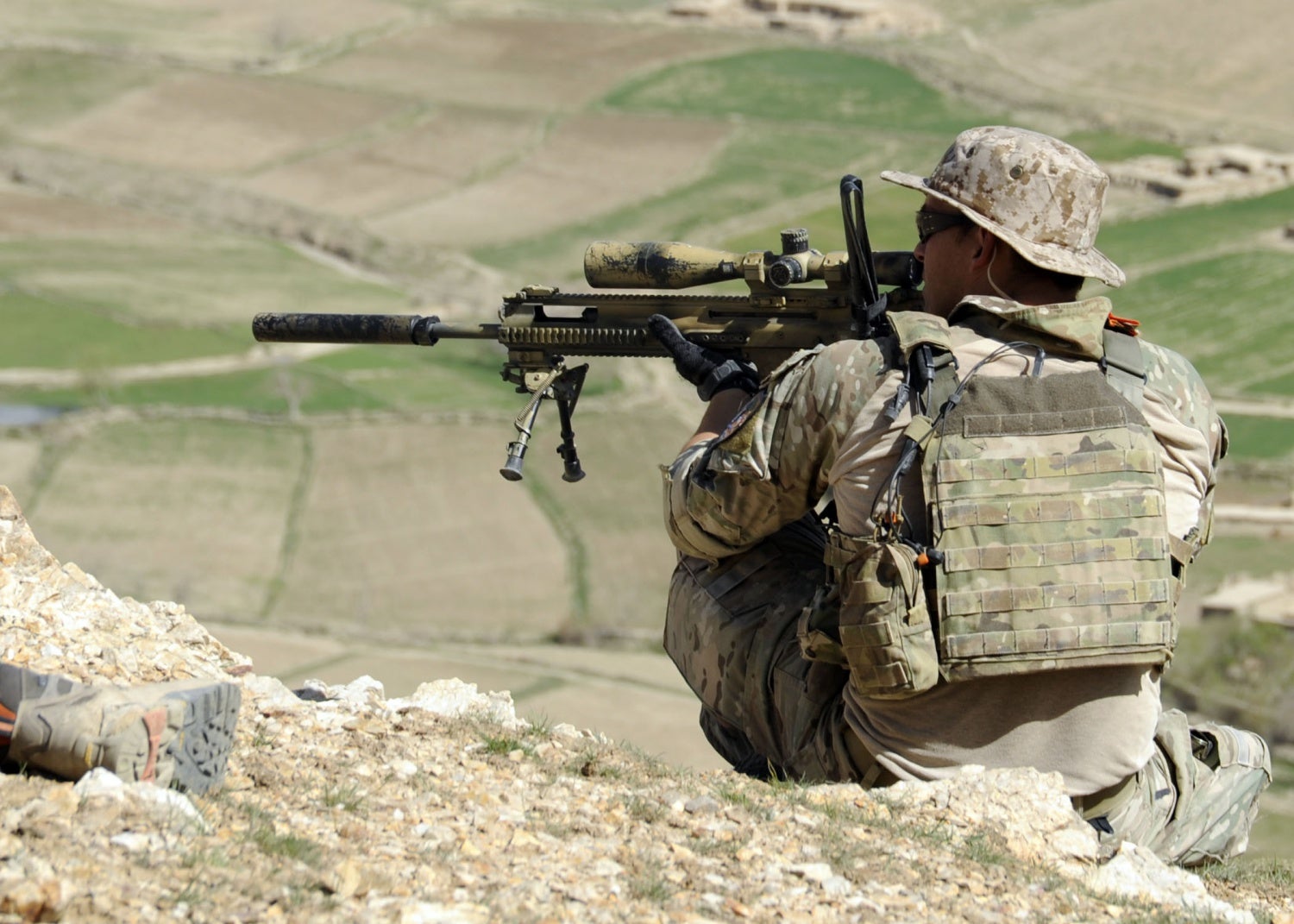
Sourced quote: “A coalition Special Operations Forces member fires his [Mk. 20] sniper rifle from a hilltop during a firefight near Nawa Garay village, Kajran district, Day Kundi province, Afghanistan, April 3 [2012].” From: commons.wikimedia.org
For illustrative purposes, I am going to create my own picture of what such a configuration would look like, which may or may not be representative of concepts put forward by specific commentators and experts. The point of this article isn’t to perfectly represent absolutely every opinion regarding future small arms calibers and weapons, but to simply explore the different tradeoffs being made in configurations of this type, and to better flesh out what the infantry platoon would look like and how it would operate in this sort of paradigm.
The first and most central change to be made in this new paradigm would be in the ammunition. Instead of having two rounds, 5.56mm and 7.62mm, organic to the infantry platoon, a new long-range marksmanship-focused system would have more even requirements for range and performance across the weapons of the platoon, and this would likely both allow for and drive a unification in the calibers. Since the infantry rifles themselves would be expected to regularly engage enemies at 600 meters and further, a round more powerful than 5.56mm would be needed, and such a round would likely also make a good substitute for 7.62mm in the weapons squad’s general purpose machine gun.
The most obvious way to accomplish this would be to simply replace all 5.56mm weapons with 7.62mm weapons, but this has glaring disadvantages. 7.62x51mm is not a very efficient round for various reasons, and it carries with it a large weight penalty that would severely hamper the longevity of the automatic rifle in a fight. While mobile 7.62mm machine guns do exist and are used in short raids and assaults by special forces, the 7.62x51mm round is just too heavy to allow the automatic rifleman to do his job as it currently stands.
Therefore, it has been suggested many times that, instead of replacing 5.56mm weapons with 7.62mm weapons,weapons both calibers be replaced with ones in a caliber in-between the two in size and weight, but benefiting from low-drag bullet designs and therefore able to match the larger 7.62mm in range and performance. “Universal” calibers like this are typically suggested in the 6-7mm bore diameter range, with 6.5mm being an increasingly popular choice. However, while small rounds like the 6.5mm Grendel have many proponents online, most produce sedate muzzle velocities that would be a serious drawback to achieving the kind of accurate, long range fire necessary to make this concept work. This lack of muzzle velocity is a very serious concern for anyone seeking to transform the infantry into a long-range force of marksmen, as even though these “slow and steady” rounds do retain energy quite well, that energy can only be put to use if the shot is a hit, or perhaps a very near miss if we are considering suppression. Because of this, rounds with muzzle velocities of 875 m/s (2,870 ft/s) or higher, like Stan Crist’s 6mm Optimum or the .264 USA, are probably the better choice for this sort of configuration. This creates a challenge for designers, as the aspects of retained energy, flatness of trajectory, and round weight, must be carefully balanced with each other to meet the needs of such a force. A solution is possible, though: It seems that a variant of the 7.62x45mm Czech, necked down to 6-6.35mm and loaded with long, lead-free projectiles, could produce the kind of performance necessary to dominate space in the 600 m – 1,000 m distance range, while still weighing little or no more than current 7.62x39mm ammunition. If this shift comes with the benefit of lightweight cases, an even more powerful round could be developed, probably similar in performance to the .264 USA or possibly even as potent as the very powerful 6.5mm CT, which outstrips the .260 Remington.
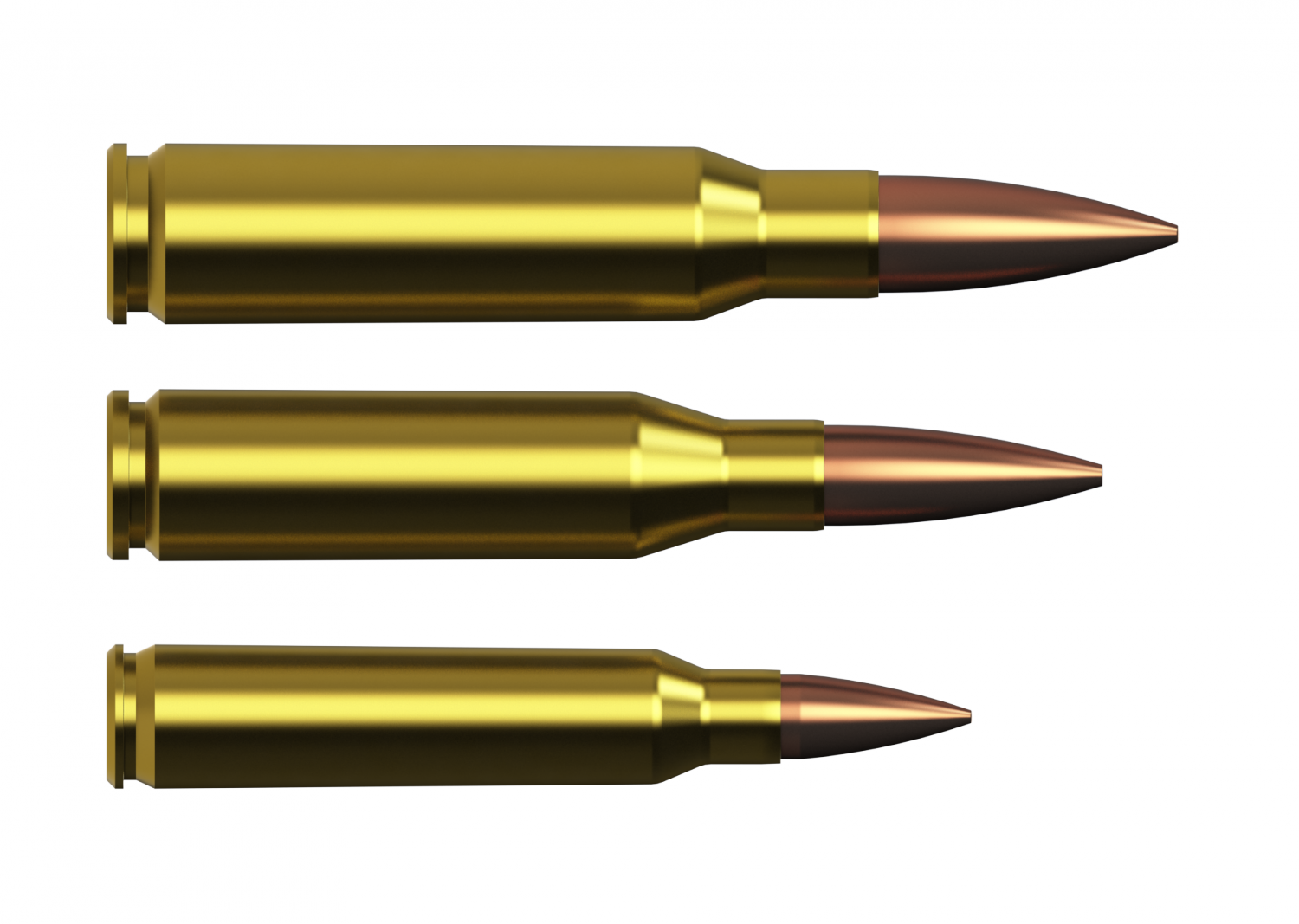
The .264 USA is intermediate in size between the 5.56mm and 7.62mm NATO calibers. It gives long range performance similar to the 7.62mm, while being somewhat lighter and lower recoil. Such a caliber could be incorporated into a long-range infantry rifle system. Author’s render.
Any of these rounds, however, would require longer rifle barrels than are currently being used. The .264 USA is specified to produce its nominal 2,875 ft/s from a 16.7″ barrel, 2.2″ longer than that of the current M4, while the aforementioned high velocity Czech-based round would need an 18 or 20″ barrel to maximize its performance. It is thus reasonable to expect that the rifles and machine guns designed for the new universal round would need to reverse the century-and-a-half old trend of shorter and shorter barreled infantry weapons, and be equipped with a barrel of length from 16 and 20 inches (406-508 mm). Also, to maintain precision even during intense firefights where fully automatic fire is needed, these barrels would need to be very thick, comparable to the SOCOM-profile M4A1 barrel that is currently being phased in with the US Army. Due to this thickness and the necessary extra length, the barrel of the new rifles alone would add a significant amount of weight to the new rifles, versus the old.
For the new rifle, this sort of weight increase will accompany most aspects of its design. Receivers, magazines, bolts, barrel extensions, and other elements of the weapon’s design will need to be enlarged in both width and (except with cased telescoped – which would need a completely new design) length, creating a corresponding increase in system weight. More weight would also come in the form of larger and more capable optics (more on those later), bipods (Harris’s popular bipod, used on the USMC’s M27, weighs – depending on model – 0.60 to 0.90 pounds [0.30 to 0.41 kg]), and other devices including the usual suite of PEQs, lights, etc.
Accounting for all these increases to reach an estimate for the weight of a new carbine is relatively simple. The current M4 (not A1) Carbine’s weight breaks down like so:
- Base rifle (no handguards) – 2.61 kg
- KAC M4 RAS – 0.240 kg
- Aimpoint M68 CCO – 0.335 kg
- Surefire M951 – 0.261 kg
- PEQ-15 – 0.213 kg
- Vertical fore grip – 0.070 kg
- 30 round magazine loaded with M855 – 0.473 kg
For a total weight of 4.22 kg (9.31 lbs). How would the new rifle compare? We can estimate this thanks to a couple of “intermediate” sized (between AR-15 and AR-10) rifles that already exist with known weights; their receivers appear to add about a pound – maybe a little less – when compared with the AR-15. So, taking the base rifle, we’ll add 0.45 kg to the weight of an M4 to compensate for the larger receiver, which (deleting the weight of the delta ring – about 0.070 kg) gives us 2.585 kg. Since the new rifle would have a heavier and longer barrel, we need to account for that. SolidWorks gives me a mass difference of about 0.41 kg for a heavy contour 450mm (17.7″) barrel, compared to the standard M4 barrel. Based on numbers for the HK416’s 9″ rail and barrel nut, we can also add about a pound (0.45 kg) for the rail system. This gives us a base weight for the new rifle of 3.445 kg, or 7.60 pounds. It’s possible that such a rifle could be a little lighter (or a little heavier), but since this is an estimate, let’s round that to 3.4 kg for the unloaded, bare rifle.
EDIT: Ugh, late night math. I made a decimal place error when doing the calculation above, which changed the end result from what it should be – 3.85 kg – to 3.445 kg. Normally, I would correct it, however I feel as though the more conservative (but erroneous) figure of 3.4 kg aligns better with the AMU’s AR-12 below (nominally 7.2 pounds, 3.27 kg), and therefore better makes my point. Still, it should be noted that the math above isn’t right. You can thank me staying up until 5 AM working on it for that!
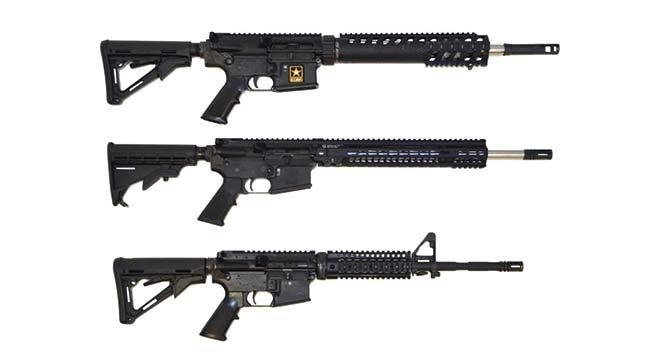
The Army Marksmanship Unit has developed an intermediate-length AR pattern rifle, designed for its .264 USA cartridge. It is about a pound heavier than the existing M4 Carbine. Image source: sadefensejournal.com
Before we calculate the loaded weight of the rifle system, we need to take a detour and talk about optics. Unlike the current fleet of M4s and M4A1s, this new rifle is intended to be very capable in combat beyond 600 meters, and to do that it needs a bigger and more capable magnified optic. We can look to the British L129A1 for inspiration, since it fills a very similar role to the rifle imagined here. It uses the quite porky TA648 6×48 ACOG, which clocks in at 36.9 ounces without piggybacked red dot, and our rifle would need something similar. However, newer optics like the Trijicon VCOG are somewhat lighter, at 28 ounces with mount and battery. Still, this gives us a range of 28-37 ounces (0.80-1.05 kg) for an optic capable enough and rugged enough to be the primary sighting system on a long-range infantry rifle. It seems reasonable, therefore, to settle on an even 0.85 kg for the optic, a conservative estimate. Keep in mind that optics are improving all the time, and so a next generation rifle of this type could possibly have an even more capable (and therefore probably heavier) sighting system, such as one with an on-board laser rangefinder and ballistic computer.
Now we can determine how heavy our long range infantry rifle system might be:
- Base rifle (HK416 handguards and nut) – 3.400 kg
- Long Range Rifle Optic – 0.850 kg
- Surefire M951 – 0.261 kg
- PEQ-15 – 0.213 kg
- Vertical fore grip – 0.070 kg
- Harris 9-13 bipod, LaRue Picatinny mount – 0.408 kg
- 25 round magazine loaded with long-range intermediate caliber ammunition – 0.605 kg
All together, a total “in your hands” weight of 5.807 kg, or 12.80 pounds. This means that, according to our estimate, a long range intermediate caliber weapon will be 1.587 kilograms (3.50 lbs) heavier than the current M4 Carbine, or a little heavier than the combat weight of the old British L1A1 SLR FAL derivative. This certainly isn’t “off the map” as far as infantry rifles go, but it is heavy, and perhaps more concerning is the fact that much of this extra weight is added forward of the rifle’s magazine, giving the resulting weapon a poor center of gravity. This would make a rifle of this type and configuration more tiring to use unsupported, which could be offset somewhat through use of the bipod in static positions. It is true that perhaps the bipod needn’t be issued to every soldier, but even if it is deleted the rifle still weighs 5.4 kg (11.9 lbs) and would still have a very forward weight-bias, although perhaps not as bad. Weight reductions versus this estimate are also possible in the barrel, optic, and other areas, but each reduction would likely come with a reduction in capability, raising the question of why the rifles are chambered for such a powerful 600m+ round if they are not suitably equipped to be used at that distance. Regardless, it should be noted that there are different potential configurations, some of which may be lighter than this estimate. It is difficult to imagine, however, how a rifle meaningfully longer-ranged than the current M4 could manage to be lighter, or even merely as light as the current carbines. It is therefore very safe to assume that any long-range rifle of this type will come with a corresponding weight penalty in addition to augmented capability.
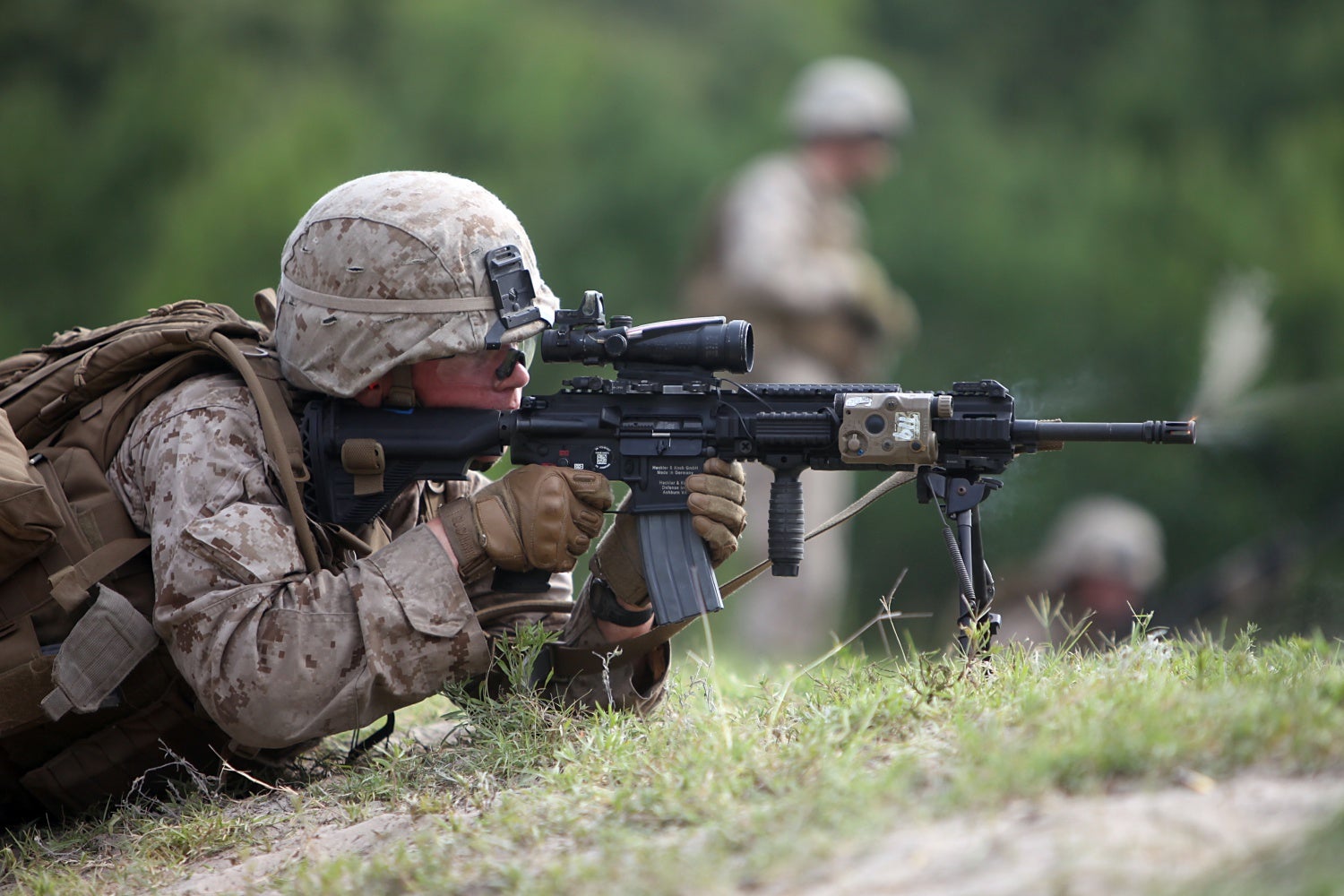
This image of an M27 IAR in full drag gives us some idea of how a long range marksman’s rifle might be configured. Equipped with a powerful optic, bipod, foregrip, and designator, such a rifle would be a heavy – but capable – weapon. Image source: commons.wikimedia.org
This is also true for cased telescoped weapons, as well. The developmental model of the CTSAS 6.5mm carbine weighs 3.95 kilograms, and is therefore unlikely to ever materialize at a substantially lower weight than the estimate quoted for the rifle above, even if substantial weight reductions are made.
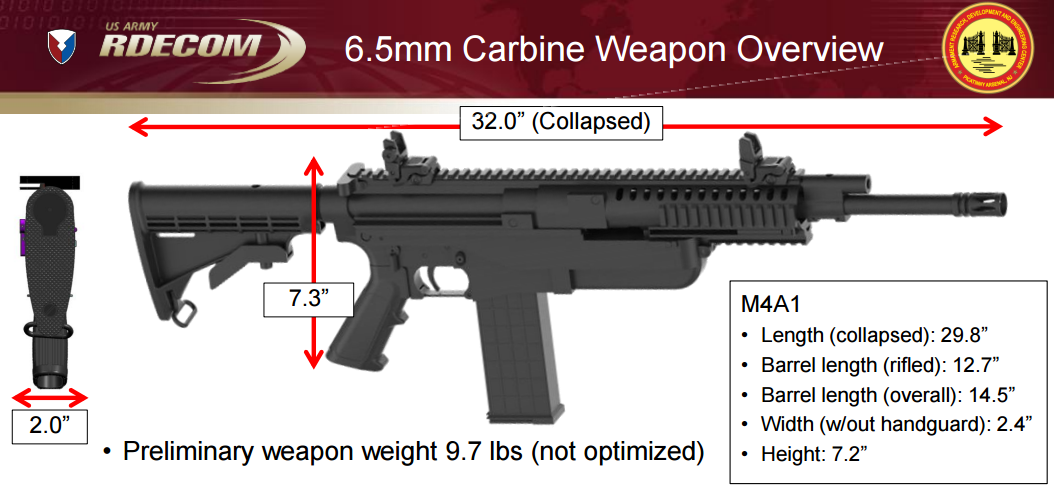
Textron’s 6.5mm CT carbine is still in the mockup stage, but currently weighs 8.7 lbs unloaded, 9.7 pounds loaded. Even if weight is substantially decreased, it will still be significantly heavier than the current M4 Carbine. Image source: dtic.mil
There is a silver lining to the additional weight, however: Even though such a rifle would by definition fire more powerful ammunition than the existing M4 Carbine, the 37% weight increase helps tame the recoil of the new rifle, and as a result very comparable or even superior recoil characteristics to existing 5.56mm weapons could be achieved fairly easily via tweaking the rifle’s mechanism and/or the addition of a modest brake. These favorable recoil characteristics would not only allow good control in the fully automatic fire mode (especially if the cyclic rate were managed down to 600 RPM or so), but also aid in making accurate, rapid follow up shots in semi-automatic – a key ingredient to the concept as a whole.
The picture gets a little brighter too when we turn to the rifle’s machine gun counterpart. Setting aside the concept of a magazine-fed automatic rifle (which could just be a variant of the above described rifle), a long-range intermediate caliber machine gun not only could replace both the existing M249 LMG and M240 GPMG, but it could potentially be lighter than either. The reason for this is that neither the M249 nor the M240 score very well with respect to weight, and there are much lighter weapons comparable to both that already exist. Perhaps the most dramatic example of this is the 17-pound Russian PKM machine gun, which is comparable in weight to the 5.56mm M249, while being chambered in the 7.62x54mmR caliber, directly comparable to the M240’s 7.62mm NATO. With a similarly optimized design, a new long range intermediate caliber machine gun could be made even lighter than the PKM, perhaps in the range of 13-15 pounds (5.9-6.8 kg) for the base weapon. This means that even equipped with an advanced optic comparable to or even better than the ones equipping the rifles, an MG in the same caliber could still clock in at less than the current M249 sans optic. In the GPMG role, this would save the gunner a full ten pounds (4.5 kg) or more versus the M240, while significantly lightening the weight of ammunition carried by the weapons squad even without the benefit of lightweight case technology.
Now that we have a better idea of what the infantry weapons of a long-range marksman-based paradigm might look like, we are ready to move on to discussing the procurement, tactics, and organization, which we will tackle in the next installment. A final note: One aspect I did not thoroughly discuss is the matter of ammunition weight. For a breakdown of ammunition weight in the platoon for polymer cased telescoped ammunition, refer to my previous articles An Analysis of the Soldier’s Load with 6.5mm Cased Telescoped Ammunition, parts 1 and 2. Also helpful is the universal caliber ammunition weight calculator published in this article.
 Your Privacy Choices
Your Privacy Choices
